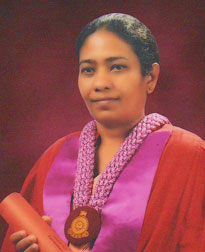Plagued by Dengue
With 23,139 cases reported so far, is Sri Lanka
heading towards another Dengue epidemic?:
by Carol Aloysius
|

Dr Preshila Samaraweera |
Variously referred to as, ‘Devil’s Disease’, ‘Break Bone Disease’,
and ‘Killer Disease’, Dengue Fever (DF) has spread dramatically on the
global scale, with the worst affected regions being South East Asia and
the Western pacific. According to the 2014 report of the World Health
Organisation (WHO), although estimates from various studies vary, the
undeniable fact is that Dengue is now endemic in over 100 countries.
This, the report states is a shocking increase from the 9 countries
affected by severe dengue epidemics in 1970.
In Sri Lanka, although the number of suspected cases and those with
clinical manifestations of the disease have dropped sharply in the past
two years, mainly due to various interventions by the Health Ministry,
the fact that nearly 24,000 cases have been reported up to November this
year indicates that Dengue fever still continues to be widely prevalent.
It also highlights the need for effective measures to control the spread
and prevent a future epidemic.
The Ministry of Health has adopted a number of emergency measures to
tackle the issue, including readying over 20 sentinel hospitals across
the island with needed equipment and vital drugs to deal with any sudden
surge in the outbreak of the disease. However, there is no specific cure
for Dengue Fever as the disease is caused by a virus – in fact several
viruses. There are four distinct, but closely related, serotypes of the
virus that cause Dengue (DEN-1, DEN-2, DEN-3 and DEN-4). Proper medical
care and new techniques have lowered fatality rates drastically globally
and in Sri Lanka. But more importantly, the infection is both
preventable and controllable.
This however depends solely on effective vector control. Spread by a
tiny mosquito, the Aedes aegypti, which thrives in tropical and sub
tropical climates, Dengue can only be effectively controlled by
destroying the breeding sites of the female mosquitoes before the larvae
left in such sites, hatches, which happens in a very short span of time.
Here, the Sunday Observer talks to Community Consultant Physician,
Dengue Control Unit, Ministry of Health, Dr Preshila Samaraweera, about
Dengue prevention, early detection, symptoms to watch out for and the
more severe Dengue Haemorrhagic Fever (DHF) and Dengue Shock Syndrome (DSS)
– that often ends up being fatal for young children.
Excerpts
Q: Dengue fever is currently raging in the island with nearly
24,000 cases reported up to November this year. Is it a common illness
due to the prevailing weather patterns - heavy rainfalls followed by
short periods of sunny skies and even drought? And which Districts have
the most number of reported cases?
A: Dengue Fever is one of the commonest prevailing medical
conditions in Sri Lanka at present. A total of 23,139 Dengue cases have
been in record so far in 2015. Nearly 50% of the case load is from the
Western Province.
Q: What exactly is Dengue? How is it caused and how long does
it take for a patient to become infected?
A: Dengue is a viral infection transmitted by Aedes
mosquitoes. Many patients infected with the Dengue virus remain
asymptomatic. Others, after an incubation period of 4-7 days, develop
febrile illness, which could lead to Dengue Fever or Dengue Haemorrhagic
Fever.
Q: What are the common symptoms of Dengue Fever?
|

TNYT |
A: If you have at least two of the following symptoms you need
to suspect of having Dengue Fever:
*High grade fever
*Headache and pain behind the eyes (retro- orbital pain)
* Generalized muscle pain and joint pain
* Nausea and vomiting
* Red spots on the skin and bleeding tendencies
It is also important to take into consideration whether you are
living in highly endemic area.
Q: When you have fever what should you do?
A: Take adequate physical rest; don’t send your child to
school during the illness; take only paracetamol to bring down the fever
on a doctor’s advice; make sure it is given in recommended doses. Also
tepid sponging of the body helps to bring down a high fever.
Q: What are the things you should not do?
A: You should avoid all Non-steroidal Anti-inflammatory Drugs
(NSAIDS) and steroids like Mefenamic acid, Ibuprofen, Diclofenac
Q: What kind of food /drinks should be consumed by a patient?
A: Give him/her adequate amounts of fluid to prevent the body
from becoming dehydrated. Nourishing drinks such as rice ‘kunjee’, fruit
juices, jeewani, milk and soup are preferable to water.
If the patient has an appetite, let him/her take his usual meals if
possible, but avoid red, brown, black, and coloured foods.
Q: If the fever persists what should you do?
A: Consult a qualified doctor if the fever persists for more
than two days. A full blood count (FBC) should be done on the third day.
Q: What are the more severe forms of dengue fever?
A: Dengue Haemorrhagic Fever (DHF) and Dengue Shock Syndrome (DSS)
Q: How serious are they in terms of outcomes?
A: DHF is a serious condition in which there is a leakage of
plasma into body cavities.
This can lead to a state of shock, which if left untreated can lead
to even death.
Q: Who are most at risk of developing this condition?
A: Young children from 1-5 years and primary school children.
Q: What are the signs and symptoms that indicate a Dengue
patient is progressing into this more sever stage of the illness?
A: -Clinical deterioration with settling of fever
-Inability to tolerate oral fluids
-Severe abdominal pain
-Cold and clammy extremities
-Lethargy or irritability/restlessness
-Not passing urine for more than 6 hours
-Bleeding tendency including inter-menstrual bleeding or menorrhagia
Q: How can you identify Dengue Fever and Dengue Haemorrhagic
Fever?
A: Through Dengue Antigen test (NS1) and Dengue Antibody test
(IgM and IgG)
Q: Let’s talk about prevention. How can the Dengue infection
be prevented?
A: If you are in an area where there are plenty of mosquitoes,
try to avoid mosquito bites by resting under a net at night and even
during the day time.
You can also use natural mosquito repellents, but it is more
important to get rid of any mosquito breeding sites in your immediate
environment and make your garden free of all small containers that
attract mosquitoes and provide breeding places for their larvae.
Q: Could you elaborate on this? Where can these breeding sites
be found?
A: There are two kinds of mosquitoes that spread Dengue. They
are Aedes aegypti and Aedes albopictus. They breed on clear stagnant
water.
They can breed in even very small amount of water. Most of the
breeding sites are man – made or natural water receptacles.
These include multitude of receptacles and roof gutters found in and
around both urban and rural environments e.g. (houses, construction
sites, religious places, schools and factories) Commonly found breeding
places are tyres, water storage tanks/barrels, containers, machinery
parts, discarded items like tins, coconut shells, plastic and glass
ware, flower pots and flower pots, trays, bird baths, earth pipes, leaf
axils, ant traps, bamboo stumps, tree holes, blocked roof gutters etc.
Q: Your message to the public?
A: The most effective method of preventing dengue is proper
elimination of these breeding sites from our surrounding.
Therefore, we urge the public to inspect their premises regularly and
prevent mosquito breeding places. |

